|

A vegetarian harvest (for a squirrel)
(*photo
credit)
October 1,
2009 World Vegetarian Day
This
author is not a strict vegetarian, but a moderate one who does not
buy meat products, and who only eats meat when a guest provides it
or at major celebrations. The abundant venison that is now given to
our parish is distributed to the poor folks coming to the door, and
gifts of bouillon and sausage are used for flavoring my different
soup for each day (see Special Issues).
Vegetarianism goes far beyond individual tastes and practices and
has far broader ramifications:
*
Resource utilization -- Vegetarianism could become a powerful
movement that could cut the consumption of animal products,
especially beef, pork and chicken. Meat eaters consume many times
the amount of grain (fed to the producing livestock) than is
consumed by the vast majority of poor folks living principally on
grain and low-meat diets. Grain fed to animals could be more
efficiently shipped to feed the one billion hungry people in this
world;
*
Animal respect -- Vegetarianism champions the existence of
wildlife in our increasingly developing world, and reduce the
production of livestock by inhumane factory farm methods such as
crowded chicken pens and feedlot conditions;
*
Food economics -- Vegetarianism is far more economical when
considering the rapidly rising food prices, especially for meat
products. As more and more stop eating animal products, they are
essentially holding down food prices, thus allowing more grain to be
available for human consumption;
*
Nutrition awareness -- Vegetarianism can make people sensitive
to the needs for more healthy diets, and start to address the
obesity epidemic in our country. It replaces a heavy meat diet by
vegetables and whole grains for anyone;
*
Meditation practices -- Vegetarianism has a spiritual dimension;
many who practice this form of diet say that it reduces anger and
stressful practices, though this is disputed;
*
Simpler Lifestyles -- Vegetarianism opens the door to a host of
other simpler living and conservation practices that are needed in a
world in crisis through global warming; and
*
Climate change -- Vegetarianism leads to lower meat consumption
and thus to less livestock, which contribute through methane
production to elevated greenhouse gas emissions.
Prayer: Lord, teach us the ways to share better the resources we have at hand
-- and to curb animal-products consumption to some degree. If we
choose to be vegetarians, at least let us do so in a non
self-righteous manner; help us to inspire others who desire to
reduce their own meat consumption, for the sake of the disadvantaged
people in other parts of the world.

A festival of autumn color
(*photo
credit)
October 2,
2009 Attend an Autumn Festival
Once a
year I try to keep a festive spirit by attending a fair or
festival. I always feel the urge to omit the event; yet, in every
case, afterwards I'm happy to have gone and kept the festive spirit
alive. Listing all the advantages of a neighborhood or regional
festival is good, and most likely you will discover more:
*
Attending and participating enhances the social assets of the
community. Festivals help us improve the glue that binds us
together. Being an attendee requires far less talent than running a
program or booth, or performing as part of the entertainment, but
attentive listening builds a deeper sense of respect;
*
Festivals encourage and celebrate a wide variety of skills and
products that are local and worth our support. I am not a great
purchaser, but just visiting with some sellers is a form of
compensation. Food booths are always popular and are usually the
most prosperous commercially, for most festival goers are hungry and
thirsty -- or at least the smells make them think they are;
* Craft
folks vary in their ability to attract crowds. We all need to
recognize the good work of others by showing interest in what they
have to offer. At times, displayers have much to demonstrate and
yet the sheer number of items will cause some good ones to be
overlooked -- and that makes the event a little bittersweet for some
who count on sales for a livelihood;
* Youth
seem to get more out of festivals than seniors, who do not have as
much energy. The face-painting locations are favorites for the
toddlers, and they add much to an atmosphere of excitement. Older
youth prefer the climbing walls or the skills needed at shooting
galleries;
*
Festival organizers require a happy combination of sociability,
patience, good grace, and energy to operate a festival, and
fortunately some enjoy doing just that. It is a civic service and a
mark of distinction to make a fair a success.
Kentucky is blessed with many annual festivals covering a wide
variety of themes. Nearby Beattyville has the "Wooly Worm
Festival," and London the "Chicken Festival." Here in Estill County
we have the "Mushroom Festival" in the spring, but the weather does
not always cooperate. Neighboring Powell County has the "Corn
Festival" in mid-summer. Festivals are part of our Appalachian
culture; they preserve our past and give many a connection with the
ways that are being abandoned. Fairs and festivals are American to
the core, and these ought to be sponsored, attended, and managed,
if you are endowed with enough time, energy, patience, social
graces, and good will.
Prayer: Lord, show us that occasional celebration is part of Earthhealing, and
that by encouraging this at a local level, we are helping to heal a
troubled Earth.
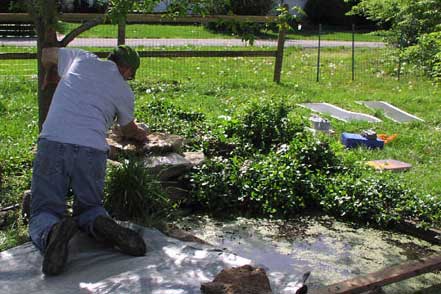
Building an artificial waterfall, powered by two
flexible solar panels
(*photo
credit)
October 3,
2009 Domestic
Solar Tours in 2009
Renewable energy is now furnishing 13% of the electricity consumed
in the United States. About three- quarters of that is hydropower
and a major part of the rest is wind and geothermal, along with some
wood and biofuels. Frankly, solar applications are currently low on
the renewable energy list, and yet they offer great promise to a
renewable energy short world. The future includes much solar energy
-- and the Saturdays of October will be devoted to domestic solar
tours in this country.
Small-scale solar home applications have (to pardon the pun) a very
sunny future, while large-scale solar applications get far more
media attention. The people who organize and sponsor these tours
throughout the U.S. are committed to making solar a leading
contributor to the energy mix (perhaps coupled with natural gas when
the sun doesn't shine).
Throughout the country home owners are showing off their residences,
and demonstrating how comfortable and energy efficient their places
are with solar energy. The ASPI Solar House has been on a tour for
much of its quarter of a century of existence. We hope that those
taking the tour will be inspired to build or acquire solar
residences of their own. They can join the pioneers in the solar
age who will save money, especially after innovative solar devices
are mass produced and made commercially available. They want to
save on ever more scarce non-renewable resources. However, many
residents choose to wait a little longer for lower priced materials
to help reduce construction costs. However, this wait-and-see is
detrimental to achieving low-cost solar energy.
Talking
to solar residents is the fastest way to acquaint a person with the
benefits of solar energy. Visitors are made to feel comfortable
enough to ask specific questions, and to catch the enthusiasm of the
solar residents; they can learn quickly about a host of solar
applications many of which are mentioned on this website (see
Daily Reflections Table of Contents)
--
Active
and passive solar space heating
Solar
water heating
Solar
food cookers and food dryers
Solar
greenhouses
Solar
compost toilets
Solar
signage
Solar
waterfalls and fountains
Solar
water purifiers
Solar
path markers and lamps.
Check
the Internet for the nearest solar tours sponsored by the U.S.
Department of Energy and many coordinating groups such as ASPI's
Kentucky Solar Partnership. Thousands of people will benefit by
touring various residences in over thirty states.
Prayer: Lord, make our journey of life include the learning tours that help us
treat our troubled Earth with greater care.
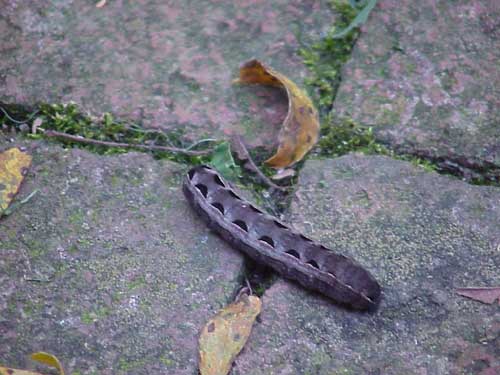
Mystery caterpillar - Reader assistance
appreciated
(*photo by
Sally Ramsdell)
October 4,
2009 Bless All the Earth
May
the Lord bless us all the days of our life. (Psalm 128)
In the
Scripture readings we see that God blesses men with women and single
life with marriage; also in the Gospel we see that Jesus blesses
children in a special way. On this feast of St. Francis of Assisi
we are more aware that blessings are extended to brother sun and
sister moon and to all the creatures of our Earth. In this
Nurse-Midwifery Week, we also extend God's blessing to these
caregivers and to the infants they help bring into the world.
Blessings are our opportunities to show our love and concern, to
become aware of the presence of others, and to be creative and
spontaneous in extending these blessings. Let the words flow, for
the blessing must come principally from the heart, not the head.
God's
blessings go out to all the world; so must our blessings, if we are
to act in a godly way. If we withhold blessings, we are creating
outer shells through which the love of others cannot penetrate. On
the other hand, through blessing we extend the Spirit that is within
us out to other creatures; thus we bring Good News to all
creation (Mark 16:15). Blessings become the primary form of
evangelization; both the sender and the receiver are blessed, and
receive the goodness of God's grace in a special way. Thus we need
to find opportunities to give either formal or informal blessings,
and to treasure those moments.
Institutional blessings involve bringing animals or people to be
blessed to a central location and having a formal blessing, which is
done on special occasions. Liturgical ministers give special
formal blessings of articles, people, places and activities. Though
this is quite popular for animal blessings, a number of churches,
schools and other institutions discourage such practices due to
liability requirements, but that seems a bit overly cautious. A
modification of the ceremony would allow each animal to stand near
the particular guardian and apart from others, but be part of an
assembled group for this formal occasion.
Habitat blessings involve going to the place where the one to be
blessed resides. The blessing goes out to all the world to embrace
all creation; people take holy (or Easter) water from the place of
initial blessing and scatter or sprinkle the rest of those needing a
show of concern (invalid people, birds, crops, trees, etc.). One
important aspect of this outward approach is that it creates a bond
of sacred relationship between guardian and animal. In fact, this
relationship is close to the mind of St. Francis, whose feast we
celebrate. It can extend to blessing caged animals in zoological
gardens, to the neighbor's confined dogs, and to birds on the lawn
or in cages. Bless the free-ranging deer, turkeys, squirrels,
geese. Bless those in hospitals and jails; animals in shelters and
pet shops, beehives, anthills, and lakes with fish. Blessing is
good for the blessed and the blessing one.
Prayer: Bless us, Oh Lord; extend your blessing through us.

An arbor of fox grapes, Vitis
vulpina, native Kentucky grape.
(*photo
credit)
October 5,
2009 The Joy of New Wine
Seven
years ago this week, my brother, sister-in-law and I were in Alsace,
France, at the St. Hippolyte festival of new wine. Crowds of people
from France as well as from nearby Belgium, Luxembourg and Germany
were celebrating as one large happy community; the people were
family units who were joyous and truly festive; they were eating
their lunches in the decorated festival grounds and drinking the
fresh unfermented fruit of the vine. Wine and celebration go
together as Jesus and his disciples knew at the marriage feast of
Cana -- for Jesus made the event notable by contributing new wine.
My
grandfather migrated from Alsace with the hope of starting a
vineyard in the Ohio Valley, which closely resembled the Rhine
Valley of his homeland in topography and climate. At that time
Augusta, Kentucky, near where he settled (after being sponsored by
his future father-in-law) was the wine capital of America.
Unfortunately, at this very time in the nineteenth century a
terrible blight wiped out the grape vines all over the eastern
United States, and much of Europe as well; so Grandpa Peter had to
switch over to mixed farming and tobacco to support a large, growing
family. However, my brother Frank strives to be faithful to his
forbearers, and promotes Alsatian as well as American wine.
Kentucky, like other parts of our country, is discovering
grape-growing once again as a substitute for tobacco- (or
marijuana-) based economies. Besides providing a livelihood,
wine-making has many other benefits. The unique taste of good wine
may indicate the tender care of the particular winegrower. In
defense of wine itself, we can cite St. Paul in the New Testament as
well as nutritionists who see value in drinking moderate amounts of
red wine for health. Being in a "dry" section of Kentucky, where
such spirits are not sold, I can gain the same red wine benefits
from unfermented grape juice. Wine was issued by the Roman military
to be mixed as a purifying agent with water, and such it was. Even
in Christ's time wine was always mixed with water, lest it be called
a "strong drink." However, at festive occasions the wine was not so
diluted as to lose its taste, as the Cana taster in St. John's
Gospel indicates.
The
taste of new wine indicates the goodness of all of God's creation,
being renewed through our celebration. Much of our Jewish and
Christian religious heritage is based on wine as a central drink --
the Passover, the "cup of salvation," and the "Blood of the Lord."
The wine was not just "natural," but had the mark of the human hands
contributing to its success as a drink. This elixir of the soul
allows for relaxation, a key to enjoyment and entertainment; and in
moderation this is a good that God allows the people. Our religious
traditions point to the Middle Eastern Judeo-Christian understanding
of the joys of drinking wine.
Prayers: Lord, teach us to be festive when the time allows, and to do so with
joy and moderation.

Pineapple sage, colors of autumn
(photo by Sally Ramsdell)
October 6,
2009 Control the Salt Intake
During
summer months we take extra salt when exercising and producing more
sweat. Certainly salt is needed for proper bodily functions
(maintaining blood volume and cellular osmotic pressure and
transmitting nerve impulses). In older periods salt was a precious
and expensive commodity but that is not the case now, and so we can
get too much of a good thing. This may occur in processed food and
even over-the-counter medicines like antacids, and softened drinking
water, causing high blood pressure, hypertension, and strokes.
While most frozen vegetables are processed without salt, some
starchy ones (peas and lima beans) are frequently soaked in brine
before freezing. Some fruit and tomatoes are dipped in sodium
hydroxide to assist peeling -- thus increasing sodium levels.
Canned and bottled citrus drinks are sometimes buffered with sodium
citrate. Sodium ion exchange is used in processing some wines to
reduce sediment and clarify the product. The high salt content of
all these ingested substances concerns people on salt-restricted
diets -- and should concern all.
The
National Academy of Science estimates that our need (as healthy
adults) is from 1,100 to 3,300 milligrams of sodium per day. It may
be best for those concerned about excess salt to drink bottled water
with no sodium content. The following table is a selection from "The
Sodium Content of Your Food," U.S. Department of Agriculture,
Washington, DC 1981.
-------------------

Prayer: You are the salt of the Earth.
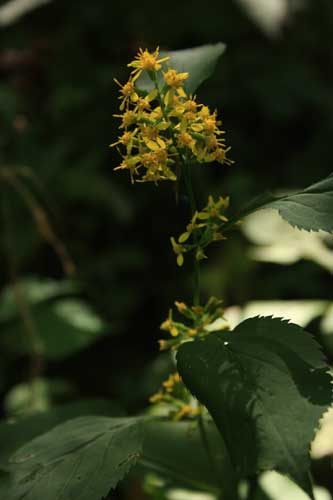
A touch of golden on the forest floor
(*photo
credit)
October 7,
2009 Americans and World Court Day
Justice
takes on a global character and thus the need for a World Court. In
theory, we Americans acknowledge the World Court, but we like to
think it applies only to the rest of the planet's inhabitants who
often lack the superior system we possess -- and our super-power
status. Our Supreme Court is our highest authority on justice
issues and, for many of us, that is the way it will remain. The
ultimate highest court is the judgment seat of God. However, is the
case closed?
In
truth, the United States does recognize certain international
authorities dealing with war crimes (e.g., the Nuremberg Trials
after World War Two) and the rights of prisoners in time of war
through the Geneva Convention. We accept that the UN Human Rights
Commission is legitimate, provided this commission refrains from
investigating too many American practices. We do subscribe to the
judgment of some supranational and international authorities in
everything from Olympic conduct to air traffic controls, from radio
signals to shipping regulations.
Having
said this, the U.S. does pick and choose when it comes to
international agencies. If an American were to be brought before
the Hague Tribunal, this nation would object vigorously. The
failure to participate in the World Court proceedings is part of
that picking and choosing. Our viewpoint has weight, because we are
the temporary "superpower," but should this be the deciding factor?
Of all countries, we should take a leadership role in supporting a
world court system that has teeth, can prosecute nationals from any
country, can give out sentences, and can enforce internationally
recognized requirements for people everywhere. Why should we flaunt
this system when, in this globalized age, we must cooperate on
everything from drug trafficking to tax havens.
Recognizing the power of a world court does not diminish our own
freedom, but rather enhances global security and champions all human
rights. Exerting power to be exclusive weakens a world cooperative
spirit and our inter-dependence that we must be willing as a nation
to welcome and support. Justice is so universal that crimes against
humanity must be prosecuted by a world court, not by national courts
such as Spain's. The fight for American independence from colonial
powers produced a working federalism that can be a primary model for
a globalizing world order. When the Constitution was adopted,
certain state activities such as commerce and international
relations were assumed by the nation. In time this proved wise, as
our country changed from being these United States to the
United States. Other powers still reside with the states. The
surrender of states rights in earlier centuries gives us an historic
opportunity to take a leadership role in moving to a federalized
world government. This applies to everything from war crimes to
climate change issues.
Prayer: Lord, help us Americans to understand that we must let go of power so
that our world may be a better place to live.
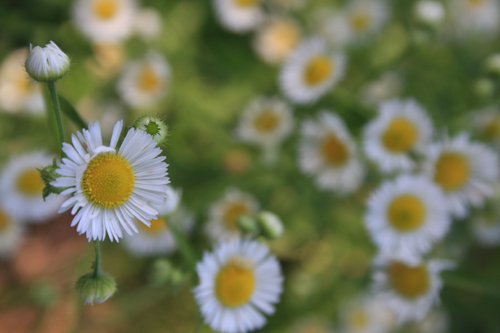
Philadelphia Fleabane, Erigeron philadelphicus
(*photo
credit)
October 8, 2009 Should We Save Battlefields
Should
we preserve historic battle sites? That is the ecological question
of the day. Some 147 years ago today, the federal and Confederate
forces clashed somewhat unintentionally in Battle of Perryville
here in Kentucky. In this pleasant bluegrass countryside these
armies met, fought and then limped away for another fight. For
battle historians and reenactors every battle detail is of utmost
importance, and so they prefer to see the fields planted in the same
crops, the same hedgerows, the same barns and homestead, and the
creeks running as free (though it was a drought) as on that October,
1862, day. Must history stand still for the sake of reenactors of
battles?
On the
side of benefits, historic sites allow people to relive the past in
a more authentic manner. Reenactment allows otherwise sluggish
adults to get out and exert themselves playing soldier, dressing in
sweaty woolens, and toting heavy muskets around for an hour or so to
martial music and fluttering banners. My years of fading interest
in Civil War battles included stopping by and observing the
Perryville event and another at Gettysburg, Pennsylvania in 1988.
However, the events were more amusing than impressive. Reenactors
admitted that those seemingly home-spun clothes cost hundreds of
dollars for an outfit. One wonders how any of these portly folks
would have fought in the real battle.
Preserving historic sites is worthwhile. A preserved site is a good
use of land for recreation, especially when thousands of sightseers
desire to have some contact with American history. Acquiring and
preserving sites shows a respect for the sacrifices of the past,
even when we do not identify with either side in ancient
struggles. Saving such landscape when not hindering commerce does
seem worthwhile. The grounds of the Civil War Battle of Franklin,
Tennessee, within metropolitan Nashville, are already lost. Certain
battlefield sites of that war such as Gettysburg and Antietam have
been preserved, though some unsightly monuments and recent
structures deserve to be removed. The preservation of sites nearer
locations of urban sprawl (e.g., the Battle of the Wilderness near
Washington, DC) requires more land purchases.
Once
several of us in our county made an issue of some loggers dragging
logs over the trenches (still visible) of the site of the almost
forgotten Battle of Wildcat Mountain, Kentucky. The media heard our
protestations and called a very famous Civil War historian who
laughed at the lack of importance of the battle. He never
understood how much of a disservice he did to our efforts at
historic preservation -- but loggers did stop logging through our
efforts. Preserving is certainly better than destruction.
Prayer: Lord, teach us to regard our past as precious and fragile, and to
realize that the means we have to preserve historic memory are worth
the effort. Change those who want to play war games to join in
preserving authentic historic sites for all to enjoy.
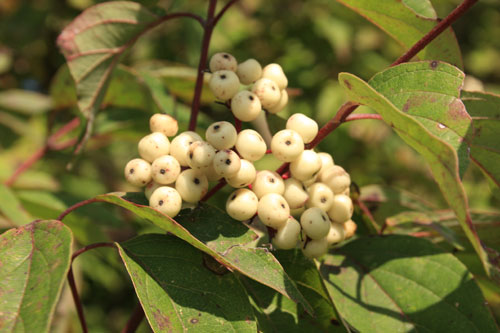
Berries of the roughleaf dogwood, Cornus drummondii
(*photo
credit)
October 9,
2009 Cash for Clunkers: Get Serious!
October
is a month when we should get serious. What about the recent
three-billion-dollar federal program that allowed up to $4,500 in
trade-in for vehicles of 1984 or newer getting 18 miles per gallon
or less? The allowance depended on the purchased vehicle's getting
at least 22 miles to the gallon. Small differences and big bucks,
right? Why would someone pass up a sizeable cash rebate on a new
vehicle purchase? Those looking for a bargain coming down the road
found it this past summer. Those who didn't were too poor or too
conservative when it comes to taxpayer money.
Certainly, the popularity of the program did not depend on the poor
migrant who drives a clunker, because there was no possibility of
affording a new vehicle. Nor was it popular with serious
environmentalists (some question as to how many there are), who
realize that the savings are very minor; they must be contrasted
with other saving through conservation programs such as compact
fluorescent bulbs or solar water heaters. The program was wildly
popular with affluent people, who had a half-used clunker around
after retirement or after the youngsters had flown the nest. The
problem with this program was it was of only short-term economic
value, was not good resource conservation and did not take
environmentalism seriously. The spurt in the sales of autos in the
summer did not endure. When France stopped such a program in the
1990s, the year after the program new auto sales dropped 20% (The
Economist, August 15, 2009, p. 25).
A rule
of thumb is that one-fifth of a vehicle's lifetime resource
consumption is in its construction, and so junking vehicles with
more life potential may not be major savings. However, the problem
was that it allowed junk dealers to strip cars of all but the
engines, which had to be rendered unworkable. The classic car lobby
worked hard to exclude vehicles made before 1984 from the
salvaging-- and thus about five million of the most wasteful running
vehicles were excluded. Other countries with similar programs do
not limit age. Germany has a 2,500 Euro-program for any car older
than nine years, other European countries have ten year limits and
Japan has a thirteen year limit.
Wasting
federal money is not a good practice, and naysayers point to this as
a way towards decline of American culture and society. Whether that
much can be said is problematic. Seriousness means that America
must effect real long-term savings, and industrial China must be
made to follow our example before it irreversible damage occurs.
Such programs as the cash-for-clunkers really reward the more
extravagant wasters of the past without putting a meaningful
alternative into effect. It is a form of postponing meaningful
resource conservation.
Prayer: Lord, teach us to be serious, especially in the Octobers of our lives,
when we ought to know better about our many
lifestyle practices.
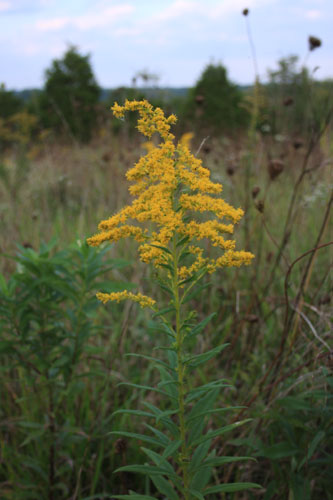
Goldenrod, reclaiming a newly-opened prairie
(*photo
credit)
October
10, 2009 We Need Fire Prevention Measures
This
essay was written in late August when there were eleven fires
burning in California, and one of these was in Los Angeles County,
which blackened over two hundred square miles and caused the
evacuation of about 12,000 people. As autumn approached more were in
store. No one likes the sound "fire," whether in a theater or over
a cell phone. We see reports and then remember fires that caused
alarm in our own lives, those in forested areas (this author helped
fight several forest and other fires in the dry years of 1986 and
1987). We are alarmed about uncontrolled fires, for disaster
hovers, especially for those living near forests.
*
Don't build homes in fire-prone areas. That is easier said than
done, because some people have no other affordable sites. However,
a considerable number of affluent folks retreat to fire-prone areas
and expect fire fighters to come when blazes erupt.
*
Clear away combustibles. Television pictures show residents
hastily clearing dead brush from around their homes in front of a
forest fire. Why didn't the dummies think ahead and take some time
to clear the same materials months before the fire? They must have
been aware that fire lines stop forest fires to some degree. Could
they not have anticipated the need, and done the cleaning as a form
of exercise? "Yes, they could." Those living in wooded areas
should have space cleared from around their residences and other
buildings -- and check each year. Inside the home, spontaneously
combustible oily cloths should be discovered and discarded.
Avoid
camp fires. Many of
us hikers and campers can remember very nice camp fires, but in dry
times such thoughts should be banished. Once in a dry Oregon
evening, some of us distant travelers started a small campfire, and
the resinous brush fuel exploded into flames. The incident made us
extinguish the camp fire right away, for fear of it getting out of
hand. The episode has haunted me ever since.
Watch
the matches. We know young children love to play with fire and
so our match supply should be hidden. The young are not the only
culprits. If smoking is still allowed in your home or place of
work, at least make sure that combustion products are not casually
discarded. Use a flashlight instead of a burning torch.
Protect the fireplaces. We enjoy a blazing fireplace, but if it
is not properly screened, sparks can be emitted in ways that can set
fire to rugs, curtains, table cloths, etc. A screen takes away some
of the coziness, but we need to remember that winter as well as
summer can be a fire season.
Consider lightning rods. This centuries-old fire protection
should be considered for buildings in elevated and isolated areas.
Prayer: Lord, help us to respect the power of fire in the manner in which our
ancestors first controlled its use.
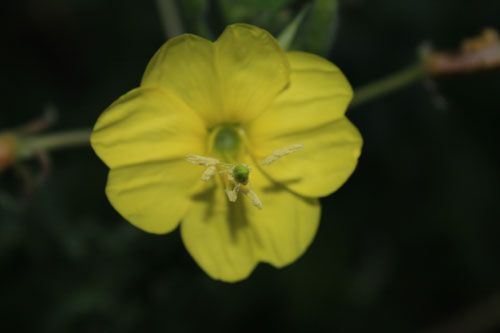
Common evening-primrose, Oenothera biennis
(*photo
credit)
October
11, 20099
Called to Be Perfect
Come
and follow me. (Mark 10:17-27)
Sometimes we read the Gospels and think they apply to others, and so
we take them lightly. One thing the Church teaches is the words of
Scripture are meant for everyone. One reply (denial) to today's
reading is that no one is perfect, and so the call to follow the
Lord applies to no one. Does it then follow that no one is called?
Another reply (excuse) is perfection eludes me but not everyone, so
the other person takes my place in following the Lord to
perfection. The third interpretation (escape for awhile) is to
affirm the validity of the Scripture, but that will come later in
one's own life after one makes a fortune, or takes care of business
through imperfect means, or on a death bed.
Yes,
Jesus is talking to imperfect human beings. In one way the rich
young man in the Scriptures was looking for more, and yet he had a
strange feeling that he had done all he could. Too often we deal
with people in such a way that they think we approve of their
imperfections. Jesus tells the rich man to forego wealth and
personal possessions, if he wants to be perfect. He must change in
order to move on the road to perfection. We all must do the same,
no matter what our state is at this moment.
Being
called to be perfect is clear; achieving that in this lifetime is
nearly impossible. What is of note is that we can attain deeper
levels of perfection if we try. Seeing this as an individual
enterprise apart from others is not really what the calling is
about. Our efforts as followers of the Lord are to bring others
with us -- not to distance ourselves from them on the road to
perfection. If love is what perfection consists in, we must involve
ourselves in the love of our neighbor, especially those who hurt
deeply at this time -- the hungry, ignorant, homeless, sick and
others. Coming to perfection is thus a social enterprise, one in
which we assist each other in overcoming the denial, excuse and
escape that afflicts so many. In our willingness to assist others,
we grow in perfection with them. In helping them we come to know
and not deny our weakness; we accept no excuse; we avoid escape by
focusing on what must be done here and now.
This
raises the age old question: do we first become perfect and then
help others? Or do we overlook our imperfections in order to help
others first? We are aware that the road to perfection is complex,
but we must balance our concern for self-improvement with helping
others with all our hearts. This road includes the risk of becoming
too self-centered in our own individualistic efforts; furthermore we
can become overly active and even do this without growing in love
for those we help. We need to keep balanced.
Prayer: Lord teach us to strive for perfection in a troubled
world where confronting our
imperfections is something we accept as part of our life's struggle.
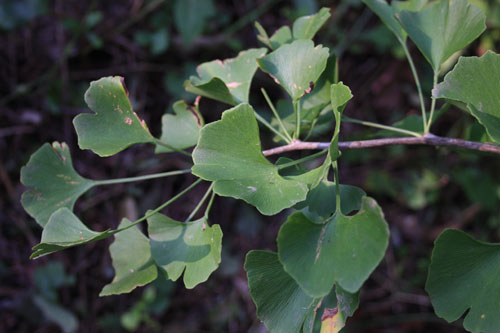
Foliage of the ginkgo biloba, green leaves in
October
(*photo
credit)
October
12, 2009 Columbus Day and Earth Science Week
Columbus Day is the perfect time to initiate Earth Science
Week, for this day of New World discovery can include the
journey to planetary discovery. The western world knew planet Earth
was round, but no one sought out the limits and attempted to
circumnavigate the globe until the end of the fifteenth century.
Planet Earth beckoned to be discovered and explored, and Columbus
contributed to opening the doors. Earth science allows us to
appreciate the beauty, complexity and fragile nature of our Earth.
Through this knowledge we are better able to protect her. Geology,
paleontology, seismology, meteorology, and oceanography all seem to
coalesce in one giant endeavor directed to explaining the phenomena
of our dynamic living planet; Furthermore, this advanced knowledge
includes the field of ecology as well. Earthhealing practices call
upon all these and more besides.
The
science of geology was really my first love, even though no geology
courses were offered by my college. The sea shells caked in the
limestone-rock layers on our Mason County, Kentucky, farm caused me
to wonder -- especially when distant relatives begged us to allow
them to take chunks of our rock back with them. The farm is
hundreds of miles from the sea, and yet sea shells and all forms of
sea life were fossilized and displayed before our eyes as almost
alive. That youthful wonder was intensified by a visit to our town
by the Jesuit, Father Hubbard, the "Glacier Priest." From him, we
found out that Alaska was another world of wonder, and that the
planet embodied an immense mystery unfolding before our eyes. My
only formal bout with geology came when invited to teach a course in
Earth sciences at a local "college without walls" in the 1990s; and
just keeping ahead of the students became a challenge. However, the
subject matter was captivating. Suddenly one sees Earth alive with
its continental drifting, ocean currents, and "ring of fire" with
earthquake and volcano activity. One imagines Earth in one great
act of giving birth to something new.
The
upthrust rock formations in northern Tennessee immediately south of
Kentucky, (and easily observable from I-75), suddenly took on
special meaning. This is also true of all major road cuts,
including the heaving rock layers at Sideling Hill on I-68 in
western Maryland. In fact, highway travel became tours through the
landmarks of geological time, whether in the east or in New Mexico
and Colorado, a trip taken immediately after the geology course.
Only by such studies does one come to respect our vital Earth and
current controversies about preserving it. The burden falls on
Earth-related scientists to detect the effects of climate change,
glacier melting, rise in ocean levels, tsunami alerts, potential
nuclear waste disposal sites, hurricane paths, natural gas and
petroleum reserves, and the moment when a rumbling volcano may
explode or earthquake tremble.
Prayer: Lord of the universe, help us to know our planet and to use the
growing knowledge of the Earth sciences for the benefit
of all
people.

Marietta
(*photo
credit)
October
13, 2009 The
Hospice Workers' Prayer
Dear Lord, at times we find it difficult work to prepare our people
for their final journey. Yet through it all we must stay cheerful
and at times this proves hard to do. Help us to stay always in a
pleasant mood.
Also give us the grace to preserve a sense of gratitude and to
constantly convey this to our patients.
Inspire us to seek from patients and/or their loved ones what
events and persons have been meaningful in their lives. As death
approaches, while the hearing sense remains, help us to remind them
of the many blessings they have to be thankful for --
*
their entire lives,
*
their relatives who have gone on,
*
their living loved ones who care,
*
their successes and learning experiences,
*
their important life events,
* and
their caregivers.
Let us be willing to create an atmosphere of thankfulness that shows
your blessings come to us all -- and extend from us all.
Make all patients willing to respond at least in their hearts to the
great things You have given to them, so that the burdens of their
final journey might be lightened.
And make us grateful people as well. We have the privilege to serve
others as part of what You have called us to do at this moment.
Lord, give us the understanding that we are right here and now
exactly where we ought to be. These, our patients, are part of the
blessings You give to us, and they deserve our full attention.
Thank you Lord, for asking us to serve you.
Amen
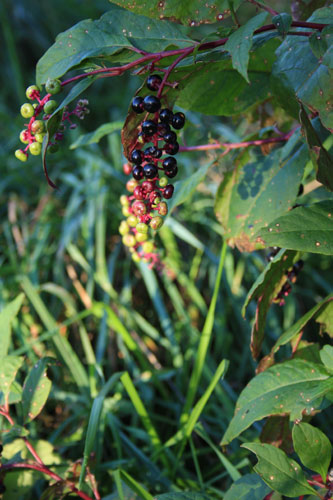
Berries of the pokeweed, Phytolacca americana
(*photo
credit)
October
14, 2009 The Peace Corps
Volunteers serve America both within and outside the nation's
boundaries. The Peace Corps is 48 years old today, and that
is worth celebrating. The spirit that generated this unique group
of volunteers is ever fresh and worthy of further support. Over the
years, Peace Corp volunteers have gone to dozens of countries in all
parts of the world, and assisted people through teaching and by
other services. The greatest gift bestowed on all parties is that
through mutual work we can make this a better world. Upon
completing service, many Peace Corps volunteers become active
citizens in the United States all their lives.
Today,
due to terrorist threats, some areas of the world have become too
dangerous for Peace Corps workers. On the other hand, after the
Soviet demise, several of the emerging nations such as the Ukraine
welcomed the Peace Corps. Certainly the need for assisting others
is still urgent everywhere, and willing volunteers continue to come
forward with each passing year. With the current financial
turndown, volunteering has actually increased. From lessons learned
from the Peace Corps and other volunteer groups, the following
suggestions are worth listing:
First,
regard volunteers going abroad to render service to others as of
equal or greater importance than the military presence in other
lands to establish security. A tithing of our military budget
(sixty billion dollars per year) should be apportioned to building
affordable housing, subsidizing small farming operations, expanding
education and health facilities, and installing clean water
facilities in poorer nations (see Disarmament Week later this
month). Thus earthhealing will be greatly enhanced through
volunteers working with generous development funds.
Second,
support a "Reverse Volunteer Corps," where people with skills from
other nations can come and assist our own people in health care,
housing, gardening and other specialties that are so needed among
our own low-income people. This addresses any residue of arrogance
that we need to act alone in bettering the world. Our nation would
benefit by learning innovative ways to conserve resources, from
people highly skilled in such practices. A Reverse Volunteer Corps
could be supported by sponsoring governments and charities and be a
way foreign young people could satisfy their military service time.
Third,
all volunteers, whether domestic or foreign, ought to be specialists
or students learning to be specialists. Volunteers must come with
acquired skills and, if they lack them, they should be determined to
become skilled with the target nation as the training grounds. The
volunteer, who is screened for aptitude, could work under native
skilled but under-subsidized teachers who could receive tuition fees
for their time and patience.
Prayer: Lord give us a spirit of generosity that inspires
many to
volunteer for part of their lives in service of others.

Corn, ready for harvest. Woodford Co., KY
(*photo
credit)
October
15, 2009 Harvesting Corn in Times Past
When the
corn harvesters finish their work this autumn, this may be at least
the second largest American corn harvest on record. From the time
the Native Americans planted their hills of corn, beans and squash
across what is now the Midwest, corn has been the North American
king of the grain crops. This was impressed upon many of us who
grew up in or near the Corn Belt. As kids, we replanted missing
sections of the corn field using a corn "jobber," cut corn stalks
with a corn knife, made corn "shocks" in the field, "shucked" corn
by hand, and loosened grains from cobs with a corn "sheller" (items
now found in agricultural museums). For making silage, we used a
horse- or tractor-drawn mechanical "binder."
Cutting dried corn stalks was hard, hot work that many of us
school kids partly avoided. It required wearing long-sleeved
shirts, buttoned at the neck on these hot autumn days, to prevent
dried leaves from cutting your arms and neck. It was sweaty, dusty,
hard, "slave-type" work, but in the end the corn was gathered in
shocks to dry and be shucked.
Shocking occurred by tying four single corn stalks together at
the top like a tent structure (two from each of two parallel rows)
and then stacking the hand- or mechanically-cut bundles first on one
side and then on another, allowing the stalks to stand vertically
(with corn ears at the top). More and more stalks were added around
the circumference until a shock emerged, which was pulled together
at about five feet high and tied with binder twine into a compact
free-standing plant structure. This process differed from less
strenuous mechanical corn picking that was being popularized after
the Second World War. In that more mechanical process, corn stalks
were mashed and even some of the ears were lost; the more opportune
of the wild geese feasted on such corn-picked fields through winter.
Shucking was labor intensive and involved the women folks and
youth; it consisted of allowing the corn to dry and the removing
the ears of grain from the stalk. Each shock was torn down and the
husking (shucking) proceeded with corn ears being piled for pick
up. The torn-down shock was then reconstructed much in the manner
of the first shocking, and would stand until used during the winter
for feeding to cattle.
Hauling the shucked corn was the final harvest stage; this
involved using a wagon to transport the shucked corn to a corn
"crib" -- an out-building, with siding with half-inch cracks running
up and down that allowed the corn to dry and not mold. The best
part of corn harvesting was riding a loaded wagon to the crib. The
sound of glistening ears hitting the wagon bed still rings in my
ears.
Prayer: Lord, the feel, smell and sight of golden corn ears seemed to say that
your bounty had descended upon us. Direct us to using this bounty
wisely for the hungry of the world.
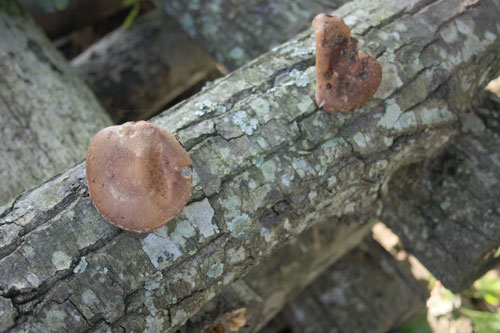
Shiitake mushrooms on log. Brooke Hill
Farm, Franklin Co., KY
(*photo
credit)
October
16, 2009 Food Shortages and World Food Day
World
Food Day has changed since those early days in the 1970s. Our
concern then was primarily both quality and sufficient quantity of
food for all. Since then access to affordable food has
unfortunately arisen as a major world concern. This year, one
billion people go to bed hungry each night, and that specter haunts
us all. Think of yesterday's reflection based on the massive corn
harvest in our own country, with perhaps upward of one-quarter of
that harvest being destined for use in making biofuels to run
America's gas guzzlers.
A
balanced food policy should look at good nutrition (quality),
sufficient affordable food (quantity), and local sources of food
where and whenever possible (access). Like a footstool that needs
at least three legs, so a balanced world food policy should stand on
its own. Emergency measures are needed, but ought not be considered
the ordinary approach; instead, ideally, all areas of the world
ought to be self-sufficient in food.
*
Nutritious food -- Some people fill their hunger pangs with
junk food (products with large amounts of sugar, fats, salt and
cholesterol), which results in obesity and other health problems.
Switching to a menu that includes uncontaminated (pesticide-free)
fruits and vegetables, nuts and berries, whole grains and
unprocessed foods is recommended. This change in food habits is
quite difficult in countries where fast food outlets are highly
profitable, and are attracting unsophisticated people to
non-nutritious foods. Nutrition information competes with the
advertising of commercial junk food, and guess who is winning out?
*
Affordable food -- By far the largest problem at the first Food
Day and one that continues unabated is that of world hunger. The
astronomical figure of one billion people, including many
youngsters, going to bed without sufficient food, or the pictures of
starving people in the Horn of Africa strike us deeply. The world
could grow all the food needed, and yet supply and demand do not
meet in a socially just manner. The rising price of food makes more
and more people unable to afford enough food to meet their essential
needs -- and many of them would be happy with basic grain and
cooking oil as their daily bread -- though a more balanced diet is
more desirable. The "steak" crowd must realize that much of the
world food resource goes to making their animal products.
*
Locally grown food -- Local lands are used for everything from
golf courses to commercial export crops. A shift from putting
resources into food donations to supporting the growth locally of
food for home consumption is of utmost importance. All should
strive to eat locally grown food, which is often more affordable and
easily accessible. Space for gardens and cropland is a major
concern for the landless and dispossessed.
Prayer: Lord, give us this day our daily bread. All of us
should become
your hands in giving daily bread to others.
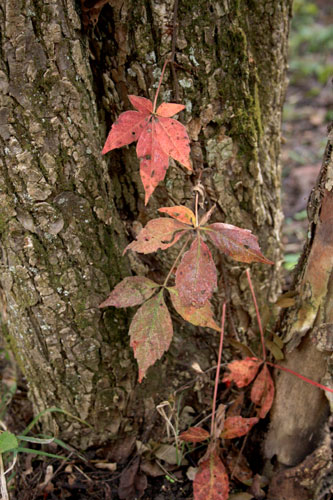
Autumn color of the Virginia creeper vine,
Parthenocissus quinquefolia
(*photo
credit)
October
17, 2009 Youth Museums and Varied Autumn Leaves
October
is leaf month. This is especially true at this time before color
change here in the "mixed mesophythic forests," which harbor the
largest variety of temperate hardwood trees in the world. Celebrate
diversity before collecting dried leaves with a rake in the latter
part of this month. In fact, in these last days of green leaves, it
is time for youth to see how many of the trees they can identify and
to collect the leaves. Amazingly, trees do fascinate youth as much
as bugs and frogs and birds. However, it is harder to launch a
youth museum with leaves -- though it can be done over time. Trees
brim with benefits from shade and shape to fruit and nuts and wood,
and their leaves are easy to collect.
Identification. Distinguishing trees requires supervisors who
know their materials -- and can tell the types especially the pines
and other evergreens. First, identify a person knowledgeable in
trees. With "Tree Finder: A Manual for the Identification of
Trees and Their Leaves," by May Theilgaard Watts (Nature Study
Guide, 1998) or a similar book one can quickly identify all the
common American trees (133 listed in this book). The collection
should include all evergreens with distinguishing needles in bundles
or tufts. For other trees, notice that leaves grow opposite or
alternately, whether they are composed of several leaflets or
simple, whether the leaflets radiate from one point or are arranged
along the twig, and whether leaf edges are toothed or smooth. For
instance, a horse chestnut (Aesculus Hippocastanum) usually
has seven leaflets, doubly toothed; the leaflets have no stalks and
the winter buds are sticky. Its cousin, the Ohio Buckeye (Aesculus
glabra) has five leaflets that are irregularly and bluntly
toothed; and the buds are keeled and the twigs have a disagreeable
smell when bruised.
Collection.
Encourage young collectors to assemble their findings into books of
pressed leaves or on a poster board with some clear plastic covering
(laminating materials) to help preserve their findings. A good
practice is to collect leaves (preferably before they become too dry
and flaky) and press them as in between the pages of a book.
Younger collectors may wish to focus on the shape of leaves from the
maple, sweet gum, tulip tree or oak. They can be fooled by the
various shapes of the sassafras coming off one plant. The leaves
should be pressed, mounted and identified for others to see -- but
that depends on the collectors'age.
Encouragement. The
result of this exercise is that the collectors begin to sense the
hidden treasure resting in the region in which they live. Variety
enriches our lives and can lead us to the Creator of all. Thank the
collectors for helping to spread Good News in their own humble ways.
Prayer: Lord, teach us to spread the Good News of your treasure in our
backyard and neighborhood. Help us to show respect by displaying
the rich variety of your creation for others to
admire.
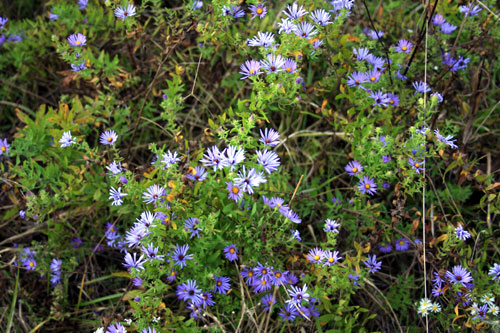
Lush patch of aromatic aster, Aster
oblongifolius
(*photo
credit)
October
18, 2009 Aspirations
to Greatness
Anyone among you who aspires to greatness must serve the rest.
(Mark 10: 42-45)
We
listen to a host of budding musicians even in their pre-teens;
breathlessly they project a message of self-promotion. We see this
in reading someone's resume, in the presentation of a speaker, in
the interview on the television or public radio. Aspirations for
greatness have been with people since time immemorial; it is in the
human bones to toot one's own horn. Are we so shocked that the sons
of Zebedee, James and John, had them as well -- a case of
"aspirations?" Our culture leads us to ask, "Are such aspirations
to greatness good or bad?"
Wrong
aspirations: Jesus
does not say, "Have no aspirations." Rather the admonition is to
find them through service of other people who are in need. Wrong
types of aspirations will lead people: to compete too fiercely for
a position; to undercut the work of another so the aspiring one can
get ahead; to minimize the need for giving attention to others so as
to build up oneself; to consider charity as the power to dictate
one's way or influence; to become greedy with a veneer of genuine
aspiring; to glory in the fame that comes from public recognition;
and to swell in self-importance when the entire exercise is a sham.
Perhaps there are still other motivations so perverse and
self-serving that they need not be enumerated. Most of us know
people, who apparently are filled with grasping and clawing to get
above the herd.
Proper aspirations:
Service to the Lord includes a desire to be with the Lord in
ministry and yet with a general indifference as to the apparent
immediate success of the service that is called for at this time.
The service must be filled with the love of Christ. The more
greatly this love prevails, the more spiritually powerful the
service whether of a long or short duration. Some saints have
aspired to serve the Lord, and many martyrs found the service
measured in days, months or a few years (Sts. Felicity and Perpetua
or many of the English or North American martyrs); others faced
martyrdom like St. Boniface after a long life of church ministry.
Service to the Lord takes on heroic forms such as that of St.
Theresa, the Little Flower; she aspired to do great things for the
Lord, yet spent her few years in the cloistered convent with a
crippling illness. God fulfilled her deep and loving aspirations by
allowing her autobiography to be widely circulated after her death
-- one of the most popular books in the world. She aspired to
greatness through service, and even asked God to render that as a
grace.
Prayer: Lord, help us to rise above the quibbling over earthly positions, and
see that what You want from us is fidelity and not success. Help us
to be humble and to give total service; help us to do this with
indifference to such conditions as short or long life, as known or
unknown.
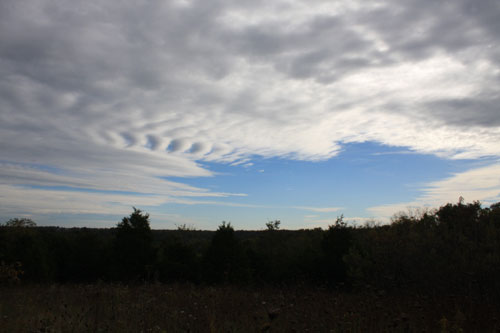
A spot of blue sky in a sea of clouds
(*photo
credit)
October
19, 2009 North American Martyrs
My last
year in formal Jesuit training, called "Tertianship," was spent in
1968 at the North American Martyrs Shrine at Auriesville, New York.
Strolling the lush grounds around the massive chapel, I wondered
what things were like three hundred years before. The French
missionaries ministered to the Hurons, sworn enemies of the
Iroquois, who lived in what is now upper state New York where the
shrine is located.
Isaac
Jogues (1607-46), John de Brebeuf (1593-1649) and their companions
set their eyes on the conversion of the Huron nation and were
successful. In their attempts to convert the Hurons, they were
caught in the middle of inter-tribal and colonial/tribal battles.
Five of this group met their martyrdom in what is now Ontario,
Canada. Jogues and Rene Goupil, a lay assistant trained in
medicine, were wounded in 1643, taken prisoner, forced to run the
gauntlet several times, and brought to the site of present day
Auriesville, New York. Here Jogues had his left thumb cut off and
endured further torture; Goupil was tomahawked to death. Jogues was
ransomed by the Dutch at Albany (Protestants) and made his way
through New Amsterdam (New York City) back to France. There he
received permission from the Pope to celebrate Mass, which could not
ordinarily be performed without intact hands. But he hastened to
return to North America to resume his mission endeavors.
By
April, 1644 Jogues was in Montreal, Quebec, and participated in a
peace conference between the French and Iroquois federation. He
wanted to extend the Good News to all the nations. Thus he felt
privileged to have been chosen to accompany the Mohawks (one of the
nations) back to their home to help guarantee the peace agreement;
the tribe's villagers, upon seeing him returning, were amazed that
their former slave was an envoy of the powerful nation of France.
Jogues returned to Quebec leaving materials with the Mohawks in
hopes of coming back. Later he and John de la Lande, a layman
assistant, went back as missionaries to the now supposedly peaceful
Mohawks. However, this tribe had just suffered a crop failure and
an epidemic, and blamed it on the materials Jogues left behind. So
he and la Lande were taken prisoner, stripped, tortured, and on
October 18, 1646, Jogues was put to death and on the next day de la
Lande suffered the same fate. Their heads were impaled on posts and
their bodies thrown into the river. Attempts to locate their
remains have failed.
Three
years later John de Brebeuf and Gabriel Lalement, while ministering
to their peaceful Hurons, saw the settlements (near Midland,
Ontario) attacked by Iroquois. These two priests were tortured,
mutilated, burned, and tormented to death. Also meeting the same
fate in what is now Canada were missionaries Charles Garnier,
Anthony Daniel, and Noel Chabanel, all French Jesuit priests. The
eight are called the "North American Martyrs."
Prayer: Lord, You give us North Americans good models to follow. May
we see that their efforts have borne much fruit.

The Canadian goose
(*photo by Michael Huey)
October
20, 2009 Observe Flying and Grazing Geese
During
October, the Canadians and the geese go south. Those of us living
near I-75 or those near I-95 on the east coast (major
Canada-to-Florida routes) can confirm the first observation. But
the familiar honking of the "v" formations of wild geese heading
south are not as frequent as in times past. Some geese certainly
migrate from the frigid upper portions of Canada and the colder
upper Midwest, but they don't go so far South. Due to warmer
winters, the geese are opportunistic enough to travel no farther
than they have to. Today many geese have found the trip too
burdensome and have opted to reside in a broad temperate band of
land in the United States. Here they enjoy relatively warm winters
and feast on corn left behind by corn pickers (see October 15) or
prefer to graze on and foul up lawns and golf greens.
Should
we even use the term "wild" for these rather domesticated geese?
These geese seem pretty tame now, for they have acquired a sense of
possessiveness that one finds in the always alert and honking
domesticated goose. They can be just as feisty, intrusive,
domineering, and messy -- and yet there is an elegance that
intrigues us about their behavior. In Lexington, they even merit a
geese-walking zone across a busy street in the eastern portion near
a lake, and they halt traffic and move slowly across as though they
own the place. Maybe they do!
For
centuries, bird watchers awaited the wild geese to announce the
change of the seasons as they honked their ways north or south. The
leaders in the "V" formation would fall back to last place, and the
next in line would take its place. They were admired as they passed
through and helped create a "change of season" atmosphere. Perhaps
it was their loud honking that drew so much attention. Such
admiration erodes when the now wild-to-sedentary geese leave their
marks in grass, on driveways and sidewalks. In fact, among the
changing patterns of wildlife, the goose has become a first class
nuisance even outstripping the increased herds of deer or the
so-called bands of "wild" turkey.
Controlling this pest is not easy. In plagued suburban and urban
areas, watchdogs can only guard so much territory. Geese naturally
switch from a pestered area to a relatively more sedate (even within
fenced areas of zoological gardens). Swans will chase some geese
from a relatively small lake. Meat eaters, willing to partake in
tough goose, should ask those who can prepare the bird well about
the right temperature and spices. All meat eaters should try to get
their food locally, and often nothing is closer than the goose or
other proliferating wildlife. Many of the non-meat eaters seem to
like the geese's presence and object to their being harvested.
Local governments must address this issue.
Prayer: Thank you Lord for what geese can do; make all of us as versatile as
they are, and lead us to see where opportunity will make us change
our practices for the better.

Franz Jägerstätter Park
(*photo by Staphan Barth)
October
21, 2009 Jaegerstaetter: Conscientious Objector
Disarmament Week is a perfect time to recount the life of
someone who touches us very deeply -- Franz Jaegerstaetter. He was
a simple farmer in Austria, living near the town where Hitler was
born. Franz was born out of wedlock to a poor farmer's maid and
brought up by his grandmother, until his mother married a
Jaegerstaetter, who adopted Franz. He did nothing extraordinary for
most of his uneventful early life, marrying, and having four small
children by the time of the Second World War. All Franz was
remembered for was serving at daily Mass; most in the village
considered him as overly devout and somewhat eccentric.
In brief,
Franz refused to fight or even participate in the Second World War,
even though urged on by his parish priest, the town's officials, his
wife, and even his bishop. His stubborn refusal to serve even as a
medical corpsman exhausted his supporters' attempts at protection.
Thus he was arrested, sent to prison, and then executed in 1943 near
Berlin over the last minute pleas of his soon-to-be widow and
others. He went bravely to his end, but so also did many of his
countrymen who died on the Russian Front and elsewhere. Each of
those dead soldiers was honored with photos and proper medals and
attributions on their gravestones, but the townspeople in Franz's
village were so ashamed and unforgiving of Franz that they buried
him in a barely identified grave site in the back of the church
yard. However, his story was discovered by sociologist Gordon Zahn,
who was researching a book on German Catholics' response to Nazism.
Thus the book was first published in 1964, entitled Solitary
Witness: The Life and Death of Franz Jaegerstaetter
(Templegate: Springfield, Ill, 1984 reprinted). Franz was now
becoming known as a singular example of conscientious objection in
that war period.
Franz's
Austrian biographer spoke to his widow Franziska and read in his
notebook, "Disciples of Christ, by the salt of supernatural
values, should keep others from moral decay, but not spoil their
lives with too much salt. Love of enemy is not unprincipled
weakness, but heroic strength of soul and imitation of the divine
example." On further reading, the author, Erna Putz, changed
from seeing Franz as an eccentric to seeing him as a mystic. She
wanted to share his hidden written treasure with other people.
(Berenice Cocciolillo, "A Hero Who Wouldn't Budge in the Face of
Nazism." National Catholic Register, March 12-18, 2000, p.1.)
A
sequel to the story: In recent years, the German government has
sent a formal apology for the death of this conscientious objector;
his native Austrian government has bestowed a medal of highest honor
on this otherwise forgotten person; pilgrims have beaten a path to
his grave site; and now the Church is considering his cause for
beatification and eventual canonization. The marvel is that one so
solitary has become so famous.
Prayer: Lord, hasten the day when we can say, "St. Franz."
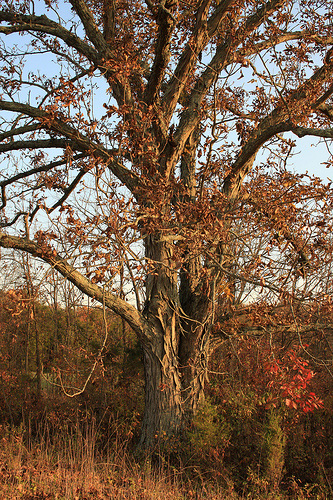
Shagbark hickory, Carya ovata
(*photo
credit)
October
22, 2009 Reviewing the Cuban Missile Crisis
On
October 22, 1962, Americans experienced events leading up to the
possible direct confrontation with the military power of the Soviet
Union, our antagonist during the four-decade-old "Cold War." It was
high drama from the members of the Kennedy Administration to young
school children. Through air monitoring techniques, our Defense
Department found evidence that the Soviets were supplying materials
for a build-up of bases in Cuba only 90 miles off our Florida
coast. Then came the revelation that missiles capable of delivering
nuclear warheads were on their way by ship to Cuba and could lead to
possible direct military confrontation.
On that
fateful October 22nd, President John F. Kennedy went on nationwide
radio and television to announce a naval blockade of Cuba to stop
the missile-carrying ships, which were already on the seas. His
talk further alarmed us all. If the Soviet ships continued on
course, the Cold War could suddenly become hot. Would nuclear
missiles be flying in both direction, and who would suffer and who
would die? Would we have to occupy those rather obscure bunkers
that had been designated for shelters in the unlikely event of a
nuclear attack? Imaginations ran wilder than at Pearl Harbor and
9-11. The anxiety lasted for several days, until Soviet Premier
Khrushchev bowed to American determination, turned his ships around,
and agreed to remove launching equipment from Cuba.
A
reflection on that October forty-seven years ago shows a number of
things: a critical situation needing resolution; a determination on
our side to go all the way; serious nuclear stakes; and an
antagonist who seemed bent on confrontation. Most of us did not
realize the full implications of the situation, even though it was
the talk of the town and nation. Only years later, after all the
details were revealed, did we come to understand the crisis fully.
History ought never to be repeated.
Maybe in
this October, 2009, we could reflect on the possibility of nuclear
risk taking and find that events could still trigger global
conflagrations. It may not be between the traditional major nuclear
powers, but between minor nuclear powers (e.g., India and Pakistan
or Israel and Iran) or between a rogue state (North Korea) and the
United States. More probable scenarios are terrible incidents
created by individual terrorist groups, who might possess homemade
nuclear weapons. Such groups could attempt to blackmail a country
-- either release prisoners or get out of Afghanistan (or Iraq or
elsewhere) lest a major American city become a target of an
improvised nuclear device. The U.S. and Russia must dismantle
thousands of nuclear warhead; nuclear materials must be under the
strictest controls; the world must stop building new nuclear
powerplants that could be sources of materials from which nuclear
weaponry can be made. As long as such weapons are around, risks may
exist that soon spill beyond national boundaries.
Prayer: Lord, deliver us from the evil of nuclear weaponry.

Thompson Creek, Anderson Co., KY
(*photo
credit)
October
23, 2009 Time to Abolish the Death Penalty
Pro-life
means allowing life to continue in all its forms and to protect and
enhance it from womb to tomb, whether in the cancer ward or the
death row, whether human life or wildlife. Certain circumstances
may make this a difficult subject, as in warfare or when
life-threatening choices must be made -- but that can be another
discussion. All pro-lifers ought to ask some questions: Can we
call ourselves pro-life, if we accept a death penalty for
criminals? Does a prisoner on death row forfeit his or her right to
life? Is there really a difference between rights to life of a
prisoner and of a fetus? Inconsistencies can be glaring. Whereas
at least half of Americans would say they are in the pro-life camp
(and the numbers seem to be increasing), a far smaller fraction of
that population desires to abolish the death penalty.
Though
deaths by hanging, drawing and quartering, beheading and crucifixion
were the means of dying for many witnesses and martyrs of old, still
along with implementing better means of incarceration and
enlightened prison reform, many countries have abolished the death
penalty. These include most countries of Latin America, Great
Britain, Australia, New Zealand, Canada, South Africa, France,
Germany, Italy, Denmark, and all other European countries. An
increasing number of these countries will not even extradite a
criminal to America, if the trial may result in the death penalty.
When in
St. Louis in 2000, Pope John Paul II persuaded the governor of
Missouri to commute the death sentence of a prisoner slated for
execution -- and the Pope later forgave his own assailant.
Americans have been very slow to follow such examples, but they are
doing so gradually. More and more Americans are joining the rest of
the civilized world and seeing that the death penalty is
inconsistent with enlightenment. Very few of us would follow the
example of ancestors of only a century or so ago, who would go to
public hangings as though they were the entertainment of the month
(though some get similar thrills from movies and tv). They appeared
to like the gore and blood. Those days are past -- as should be any
form of execution.
Execution of an innocent person is a crime against humanity. When
such happens, prosecutors and judges ought to face trial and serve
time behind bars. After investigation using modern DNA testing
methods, a number of prisoners on death row have been proven
innocent, causing some American governors to call for a moratorium
on executions. Even those with no proof of innocence could still
reform themselves while behind bars. A tragic scene is that of
victims' families, rejoicing at an execution. Double victimhood!
The prisoners opportunities to repay society in some way are truly
pro-life, and must be seen as such.
Prayer: Lord, You are the giver of all life; give us the courage to help
sustain and preserve life to the best of our
ability.
Help us support the movement to remove the death penalty.
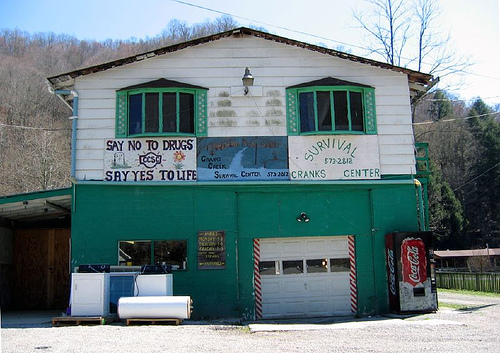
The Cranks Creek Survival Center (see story,
click here)
(*photo
credit)
October
24, 2009 We Can Each Make a Difference
Listen
you folks out there in 110 countries: today is Make a Difference
Day. We may be only one or two, but we can make a difference
provided we believe we can. On the very day that I write, one of my
parishes buried a man who truly believed he could make a
difference. Steve Collingsworth was a self-made man, a pleasant
fellow, who always had other people at heart no matter what their
troubles. He helped develop a device to reduce the impact of the
destructive force of vibrations coming from the blasts of explosives
used in mining and road construction. His device and its improved
versions did just this so efficiently that mining companies clamored
to obtain it. Through his efforts that device is today used in
operations all over the world. With an astounding ability to do the
best he could with what he had to work with, Steve made a difference
as testified to by his grandchildren and mining engineers as well.
Some say
the world will only be better, if leader engage fully in major
social or political issues. True, leaders do make a difference, but
so do the rank and file who quietly perform tasks with fidelity and
believe that good can come from their efforts even after we are
gone. The heros and heroines of this month testify to this. St.
Theresa of Lisieux or the "Little Flower," through her quiet
sufferings for others and her autobiography, which was widely
circulated after her death believed she could make a difference.
St. Teresa of Avila, who reformed many communities through almost
solitary efforts, believed the same; St. Francis of Assisi, who
started to rebuild a chapel stone by stone, believed his efforts
would lead to a community project. Danny Green, who came to
Kentucky and started the small David School in Floyd County for
troubled youth, thought it as well.
Little
acts done in an atmosphere of faith, hope and love can become big
ones. For every composer, philosopher, general, or artist who
determined to do great things well, there were millions who cared
for the elderly, taught classes or tended a garden well and went
somewhat unnoticed. They have made a difference. We find it
difficult to encourage the bed-ridden with little hope of recovery;
however, when they offer their suffering for the good of others,
their small act becomes an immense one -- provided they do so with
love. These become co-sufferers with Christ in the continued act of
Calvary extended in space and time; they help as part of the church
in filling up what is wanting in the sufferings of Christ --
recognition and powerful acceptance. When the final accounting is
done, we may be quite surprised to meet those who really did make a
difference, not just those who have an overly inflated opinion of
the power of their own actions.
Prayer: Holy Spirit, inspire us to help make a difference,
knowing we come from different circumstances and with different
gifts. Help us to see differences as opportunities, not barriers,
to see that what others have done in their lives, we can do in a
similar manner in our own.
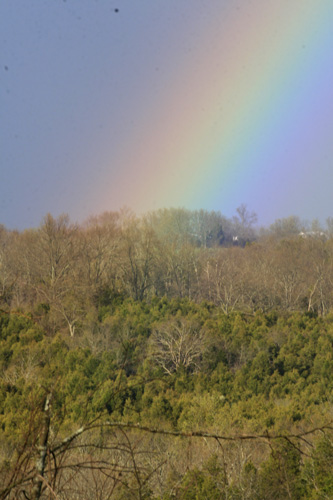
Vivid raibow on autumn day
(*photo
credit)
October
25, 2009 Seeing the Need to Disarm
Master, let me see again. (Mark 10:51)
In the
Gospel reading today we note that Bartimaeus, the blind man, once
saw physically, but is now in a sightless condition. He calls on
God's compassion to see again; he realizes he cannot effect the
change himself, for he needs divine help -- and he trusts that this
help will come.
So often
we read the Scriptures and see the incident as singular, and not of
direct consequence to us in our own lives. This is a mistake even
for those with fairly good eyesight. We deny the Scripture applies
to us, we excuse ourselves from such considerations, and we prefer
to escape into a world of the spiritually blind. However, we all
are Bartimaeus in some way. We are blinded by the cheap thought
that expensive military might will truly correct our world. We fail
to see that seeing involves a disarmed world, and that we cannot
bring about disarmament without God's help, We need this divine
assistance much as an infant needs a mother's tender care.
This
past summer we heard of citizens going to town hall meetings
exposing their side arms (generally pistols, sometimes even
automatic weapons). Really, the right to bear arms was called for
when there were single-shot muzzle loaders. Toting arms about when
debate is heated can be quite unhealthy, for it says to the unarmed
that force will have its way in the end. Is it not direct
intimidation of a free and democratic people showing that some can
only win by force of arms? Maybe this approach is more American
than we choose to acknowledge. The world is becoming overwhelmed by
weapons of every sort, and spends over a trillion dollars a year on
such expenditures. This is utter blindness, not by natural
accident, but deliberately by those who pretend that through weapons
peace can come. The perversity rests in an arms race that actually
enhances the belligerent nature of armed people. That would not be
the case if the armed were doing peacetime pursuits such as building
decent housing, feeding the billion hungry, curing the sick,
educating the unschooled, providing potable water and giving
employment to the jobless.
The
captains of the arms industry want the public to believe in the
blindness of armed might -- for that helps their profits. Just to
curb one expensive weapon such as the now curbed F-22 fighter is a
massive undertaking, and yet the cost of such weapons run into the
billions of dollars. Give the fighting forces the best -- food,
protective gear and medical treatment. When it involves worthless
aircraft carriers and sophisticated weaponry, we -- manufacturers
and taxpayers -- are blind and need divine help.
Prayer: Lord, help us to see again and to be willing to see that peace comes
through peaceful, not warlike means.
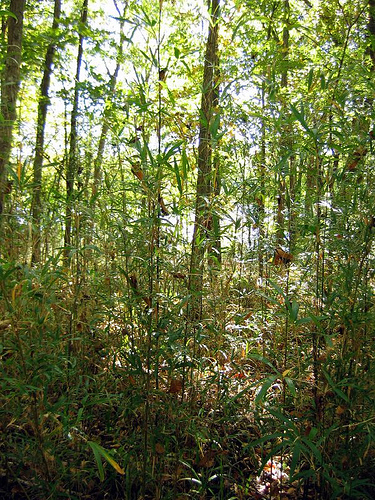
A dense stand of American bamboo
(*photo
credit)
October
26, 20099 Promote
American Bamboo
Most of
the 250 types of "bamboo" are native to Asia, but we do have three
American varieties: "river cane" that grows in river bottoms of
Kentucky and neighboring states; switch grass that grows throughout
the Southeast and is proposed as a future biofuel; and recently
discovered "hill cane" in the Appalachian range. At the ASPI Nature
Center we once had an environmental visitor from Colorado who was
most impressed by the bamboo we took for granted. Natives are used
to seeing river cane growing in virtually impenetrable "cane
brakes." River cane is not stately like many of its Asian cousins;
it grows to about ten feet in height and one inch in diameter. In
pioneer days the river cane covered large areas of the Bluegrass and
surrounding regions. Horses and larger herb-eating animals would
munch on the stalks with their nutritious contents (eaten during all
seasons of the year) and would eventually trample the cane down and
destroy it. Many cane areas were burnt and cleared for farming and
pasture, and so the cane brakes gradually diminished in size with
the late eighteenth- and nineteenth-century settlements. Only where
livestock were absent would the remnants of the cane brakes survive,
in such places as the Rockcastle River bottoms of our demonstration
center.
River
cane is limber and yet tough enough to be used for staking tomatoes
and beans; the stems could be bent into hoops to make cold frame
supports. Like their Asian relatives, American varieties are
propagated through their rhizomes (the creeping stem lying near or
under the surface of the ground from which new aerial shoots
develop). If not disturbed, bamboo will spread and thrive, with new
growth occurring each spring. The shoots mature quite rapidly and
thus form the beginnings of the cane brake. Some early pioneers
described these walls of organic matter as so thick that they could
not walk through the patches. Thus they regarded cane as a problem
worth conquering, through aggressive cutting, burning, and grazing
by free-ranging livestock.
Americans show interest in many varieties of bamboos, which thrive
in a variety of climatic and soil conditions. The American Bamboo
Society promotes many of these varieties. Adam and Sue Turtle run
the Earth Advocates Research Center in Summertown, Tennessee, which
has on its 45 acres some 250 species and forms of heat- and
cold-tolerant bamboo. However, whether we should promote all of
these Asians bamboos is quite problematic, for some can grow
vigorously, though they are not really invasive. Adam Turtle says,
"If you're not willing to manage it properly and harvest it
periodically, don't plant it." Of all places, the back yards of
the Georgetown area in the District of Columbia have dense thickets
of Asian types of bamboo. Should some bamboos be allowed to coexist
side by side with American bamboo? Shouldn't this useful and
prominent American plant be celebrated in a special way?
Prayer: Lord, allow us to see that our humble American bamboo has its own
special place and should be allowed to flourish; help us to treat
all flora with respect.

View through large windows of Frank Lloyd
Wright's Rosenbaum home
Florence, AL
(*photo
credit)
October
27, 2009 Relishing Autumn Scenes
Sometimes we are tempted to grab onto the glorious colored leaves on
the maple outside and cover the tree with a transparent coating --
to laminate the landscape. Then we realize that attempting to make
permanent what is transitory is not the most perfect exercise --
though our journey of faith seeks an eternal horizon. Rather, is it
not better to treat autumn colors as a moving beauty, a treasure
worth enjoying and not grasping?
With the
sharpening wind and the declining sunlight, many of us are tempted
to reduce the amount of time we get outdoors each day. It is
perhaps natural that the human body finds it difficult to adjust to
changes in weather, and doubly difficult to find time in shortened
days to do outdoor exercises. The only consolation is that the
weather is cooler than during those hot months when exercising in
the blazing sun was troublesome and even dangerous. October has
less daylight but also less heat. Just getting out is an
undertaking, but for the sake of health and well-being let's
consider these suggestions:
* Do
take photographs, if that moves you. Who knows, it may be the best
scene and shot ever done by you -- and that will give satisfaction
after the actual scene has faded. Encourage the amateur landscape
artist to consider this ideal time;
*
Encourage others to get outdoors and take in the scene or do a
little extra exercise. Reaffirm the health benefits of getting
outdoors -- fresh air, full spectrum sunlight, and a reduction of
stress by immersion in the autumn glory;
*
Rearrange your busy schedule to get a little extra time to relish
the autumn in the morning, or better when the sun is setting, and
perhaps enjoy the period with others who may not have the
opportunity to get out much. Relishing the outdoors can become a
social event;
* Dress
for the changing season when moving about outdoors. Proper gear
makes relishing the outdoors more memorable. Autumn glory is
fleeting and so pause an extra moment and just take it all in -- in
relative comfort.
* Move
about outdoors. Merely sitting to relish the beauty does not give
the fullness of the transition before our eyes, as we hear the
leaves fall and hit the ground. Rather vary the time by walking,
hiking or jogging at your own pace, but take in the scene for it
will soon end as do all good things.
Prayer: Lord, we cannot relish your created beauty properly
without thanking You for these and all gifts, even our sense of
gratitude that comes from You. You are eternal but we are mortal,
and the autumn tells us this, if we only immerse ourselves in the
transitory landscape.

Perhaps not such a wisely chosen snack...
(*food and photo by Matthew Maguire)
October
28, 2009 Choose Snacks Wisely
These
cooler days are a perfect time to consider those sweets that give
some extra energy such as pies and cookies and candies. But should
we be so tempted? In days of heavy exercise and growing limbs such
delights were not that hard on us. However, for those who play
video- or computer games when they should be outside or who are just
plain older and more weight-gain-prone, snacks can cause problems
that can slip up on us. We are all aware of obesity problems in
our nation and in the areas where this author resides. The couch
potato is generally a compulsive snacker, as are those working
around food processing or near to a snack filled refrigerator or
storeroom. Snacking is the way some people get nourishment, while
avoiding spending time in sit-down meals. Nutritionists admit that
merely eating larger amounts three times a day is not the better
procedure. Eating more food earlier in the day, and less later, is
regarded as the best practice, but there ought to be limits on the
number and quality of the snacks.
Let's
avoid the cheesy, sugary, creamy, oily, and overly salted prepared
snacks. Yes, avoid the corn puffs, creamy cup cakes, cheese dips,
potato chips, onion rings, soft drinks, candy bars, and cookies.
Instead, pass over the aisles in the supermarket devoted to these
packages of materials that smell so good and look so inviting. You
don't have to go cold turkey on snacks when hunger pangs occur.
Change to some of these often made suggestions:
*
Celery or carrot sticks;
* An
apple a day or an alternative piece of fruit;
* A
slice of melon or watermelon;
*
Unsalted popcorn with garlic and chili in place of salt;
* Raw
broccoli or cucumber slices;
*
Peanuts or other nuts;
* A
drink of water or sugarless herbal tea;
* A
walk or a special break.
I had a
portly colleague in the 1970s who would get a drink of water each
time the hunger pangs mounted, and that held his weight within his
acceptable limits, and seemed to give him enough satisfaction to
tide him over to the next meal. He would say that it was certainly
better than a cigarette break.
Having
said this, what about extra October snacks? If you must feast,
regard this as a special once-in-a-season celebration, unaccompanied
by too many other sweets. Moderation in all things does not mean
always fasting from what you like -- only using it within
constraints of moderation and proper weight watching. What about a
piece of pie being a reward for doing some extra physical labor for
a friend? That could be good in these October days.
Prayer: Lord, help us to learn to use the good things of life in moderation,
and to find suitable substitutes for them.
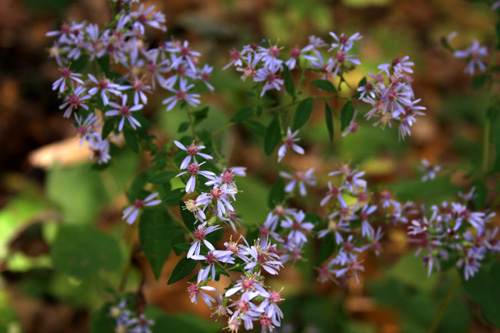
Identifying asters... an enjoyable autumn hobby
(*photo
credit)
October
29, 2009 Eightieth Anniversary of the Stock Market Crash
On Black
Tuesday, eighty years ago today, the stock market crashed in New
York City. The Dow Jones Index that was at 381 in September had
fallen throughout October, and it dipped to a low of 230 (40% loss)
on October 29, 1929. This event created a dark mood among all
traders and investors, and led certain dispirited people to jump out
windows -- of upper story buildings. Also the crash resulted in a
thirty billion dollar paper loss in stock worth, and four thousand
banks closing their doors. The few living survivors, who took part
in those bank runs in 1929, remember the sobering effect of that
day. Confidence in the American economic system was shaken.
Following the crash, people hoped that because of certain banking
reforms and stock trading stoppages such a tragic event would not
reoccur. Does history ever really repeat itself?
Being a
fiscal conservative makes me more aware that historical patterns do
reoccur -- and could even go beyond the recent financial downturn
and scare (the worst since the period immediately following that
crash). We fiscal conservatives of whatever stripe think so. In
fact, an Associated Press poll of 1,000 adult Americans this past
July found that 70% of those polled were worried about the size of
the federal debt, either some or a lot. Several key ingredients of
fiscal uncertainty include:
*
Worker layoffs continue though at a slower rate than earlier in
the year, but the shedding of a quarter of a million jobs during the
summer months does not bode well, especially when a vastly
increasing productivity is through the labor of the still employed;
*
Federal indebtedness mounts at an unprecedented rate (1.58
trillion this year alone for the U.S.). The military in several
forms take up 57% of the budget and two wars cost our nation
billions of dollars. Meanwhile, the three big federal entitlement
programs (Social Security, Medicare, and Medicaid) threaten to
overwhelm us.
*
Household debt (13.8 trillion dollars) mounts with many
consumers saddled with oppressive interest and mortgage payments and
those worrisome health insurance co-pays. The individual consumer
debt is about $12 thousand per person exclusive of mortgage (total
indebtedness per person was $45,115 in 2007). Wages have not gone
up, and advancement is harder to come by. Up through 2008,
Americans savings plummeted from 11% savings in the post-World War
II era to nearly zero, the lowest rate of any developed nation
(though savings are now occurring in 2009); and
Banking and other corporations have bounced back for the most
part but there are still weaknesses in autos, airlines and
construction.
Prayer: Lord, give us the clear vision to see things as they really are, and
where that is going to take us.
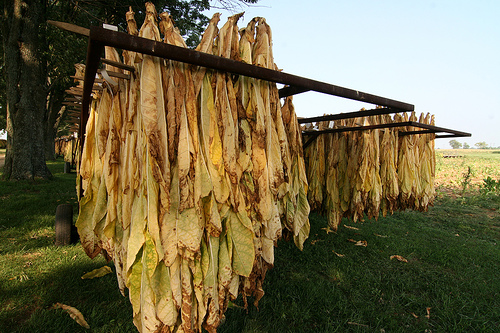
Tobacco harvest, Pin Oak Farm (University of
Kentucky)
(*photo
credit)
October
30, 2009 Redeeming Tobacco
The
remnant of the burley tobacco-auctioning season is to start next
week, but things are changing in the American Tobacco Belt. The
golden leaf, the principal cash crop, which benefited a hundred
thousand small- and medium-income farm families, is now fading
fast. Tobacco products are looked upon with disdain; tobacco taxes
have increased; smokers are either quitting or dying (400,000
premature deaths in the U.S. alone this year); companies are being
sued and are paying fines that are funding cessation programs in
more progressive states. Those of us who once grew tobacco thought
we were enhancing the enjoyment and release of stress of many, but
discovered over time that the perceived benefits were really
terrible health risks.
Can the
plant that we liked so much, Nicotiana tabacum.,
be redeemed? We are now aware that what we thought was beneficial
was harming users -- including people who shared living space with
smokers. But was this really the fault of tobacco, or its misuse,
through enticement from commercial advertisers who focused on
hooking unsuspecting youth or stressed young soldiers? Few
recognized that the plant itself has unique characteristics, which
can be beneficial to human beings. Researchers show that the
tobacco mosaic virus can trigger the infected plant to produce the
proteins of the virus. When selected genes are slipped into the
tobacco plant, it becomes a protein factory with its capability of
incredible biomass production in a very short period of time.
A
tobacco vaccine is much less expensive than traditional methods. As
with other vaccines, the body produces antibodies, thus building up
an immunity to later infection. Work is being directed to cancer
research (even breast, prostate and other forms) and to non-Hodgkins
lymphoma. The drastic nature of the disease involves copying itself
endlessly, unless inoculations of an antibody produced can stimulate
the immune system to attack the patient's lymphoma cells. Using
tobacco plants, the customized vaccine can be produced rapidly and
cheaply. Genetically engineered mosaic virus can yield large
quantities of the cancer antibody fragment. Testing is a slow
process and has not reached the human testing stage yet, but
hopefully success is up ahead.
Tobacco
is called "the fruit fly of the plant kingdom" because of the ease
with which it can be genetically engineered. Among the many
possibilities besides vaccines, specifically engineered tobacco
could produce a variety of human enzymes, polymers, plastics,
industrial chemicals, pharmaceuticals, and a variety of consumer
product ingredients. Tobacco is an amazing biomass producer; the
tiny seed can produce plants four to six feet tall in three months;
tobacco has been optimized for leaf growth; each plant can produce
up to a million seeds; genetically engineered seed could produce
many acres from the first generation.
Prayer: Lord, help us see that creatures that we misused in life, can now be
redeemed for the benefit of all.
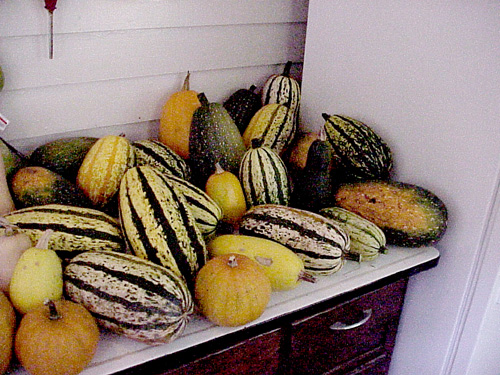
A fresh harvest of autumn squash
(*photo by Sally Ramsdell)
October
31, 2009 Should We Smile on Halloween?
The
commerce in costumes, face masks, and decorative paraphernalia makes
Halloween a major commercial opportunity for many businesses large
and small. But ought we to promote this day? The majority of
Americans do NOT celebrate Halloween; we endure it. That includes
many seniors, adults, and owners of properties, which could be
damaged by the trashing that occurs on some Halloweens in rural (and
some urban) parts of our country. "Trick or treat" is dreaded by
some parents who fear a possible misdeed by beggars. Halloween is
also not celebrated by some strict Christian groups, because of its
pagan origins -- that predated the Christian era. Communities are
making more efforts in recent years to offer substitutes for
witches, goblins and ghosts of traditional Halloween through their
own controlled celebrations.
On the
other side of the philosophical divide, one finds a number of
people, young and old, who consider this a time to celebrate, to
put on costumes and have a ball, to carve pumpkins into
jack-o-lanterns, to attend horror shows, to decorate halls with
black and orange streamers, and to take children from house to house
in safe neighborhoods hoping for treats. Promoters make a good
argument that we have baptized other pagan feasts occurring at the
time of Christmas and Easter. Why not this one on at the eve of All
Saints Day (which was organized to counter this pagan feast)?
Whatever the reasoning, the discussion calls for a certain patience
among people not wanting to celebrate, but not stopping those who
do.
Halloween is part of the
fading glory of October when we turn from outdoor to indoor
activities, from cooled to heated space, from light clothing to
heavier garments. We await the dreaded weather (for some) as nature
seeks its annual rest period. We need to pause as well and see that
some enjoy celebrating in ways that others do not find as
entertaining -- and this requires us to go along. In fact, we need
to smile and be hospitable when the celebrating little folks come
knocking at the door with their costumes. Remember this is one of
the only folklore events for youngsters in our busy culture, which
gives them so little attention. Maybe as we end a month, when we
were quite serious about the change of seasons, we ought to loosen
up. Let's give a little to the merrymakers and those who are on the
look out for sweets and treats. Just be patient and refrain from
giving them junk food. Is this asking too much?
Prayer: Oh Great Spirit, You moved across the waters and
changed darkness to light. Give us patience to build community with
our fellow human beings who are acting in unusual ways on this day.
Teach us to lighten up and smile awhile, and see this as a better
way to change misguided practices than by assuming a dour look.
Help us to gently encourage all to cooperate in building community,
so that all of us can cooperate all the more with the work ahead.
Remind us again that there is power in our smile, and we do not have
to wear masks to reveal it. |